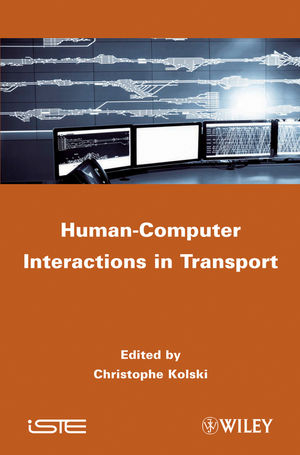
Human-Computer Interactions in Transport
ISTE Ltd and John Wiley & Sons Inc (Verlag)
978-1-84821-279-4 (ISBN)
Christophe Kolski is Head "Human Reasoning and Human-Computer Interaction" research group, LAMIH, University Valenciennes.
Introduction xiii Acknowledgements xix
Chapter 1. Principles, Issues and Viewpoints of Traveler Information in a Multimodal Context 1
Guillaume USTER
1.1. Introduction 1
1.2. A complexity that must be mastered 2
1.3. Multimodal information 5
1.4. The viatic concept: accompany the traveler 8
1.5. Other traveler information-based representative research projects in a multimodal context 10
1.6. Viewpoints 16
1.7. Bibliography 17
Chapter 2. User Needs Analysis Methodology for the Design of Traveler Information Systems 21
Pierre MORIZET-MAHOUDEAUX, Annette VALENTIN and Assia MOULOUDI
2.1.Introduction 21
2.2. Traveler information: a pluridisciplinary matter 22
2.3. The example of the P@ss-ITS project 23
2.4. RAMSES methodology for the collection, analysis and modeling of user needs 24
2.5. RAMSES in the context of the P@ss-ITS project 35
2.6. Conclusion 45
2.7. Bibliography 46
Chapter 3. A Generic Method for Personalizing Interactive Systems: Application to Traveler Information 51
Mourad ABED, Abdouroihamane ANLI, Christophe KOLSKI and Emmanuelle GRISLIN
3.1.Introduction 51
3.2. Personalization in HCI: examples of existing approaches, at the origin of the approach proposed 52
3.3. PerMet: method for the development of personalized information systems 57
3.4. PerSyst: personalization system supporting the PerMet method 62
3.5. Application to the public transport of people: itinerary search 65
3.6. Discussion about the possibility of generalization relative to personalization 84
3.7. Conclusion 86
3.8. Bibliography 87
Chapter 4. A Formal Framework for Design and Validation of Multimodal Interactive Systems in Transport Domain 93
Linda MOHAND OUSSAÏD, Nadjet KAMEL, Idir AÏT SADOUNE, Yamine AÏT AMEUR, Mohamed AHMED NACER
4.1. Introduction 93
4.2. Concepts of multimodality 94
4.3. Formal design 97
4.4. Use of formal methods for input multimodality 100
4.5. Use of formal methods for output multimodality 109
4.6. Conclusion 124
4.7. Bibliography 125
Chapter 5. From Human-machine Interaction to Cooperation: Towards the Integrated Copilot 129
Thierry BELLET, Jean-Michel HOC, Serge BOVERIE and Guy BOY
5.1. Introduction 129
5.2. Copiloting and human-machine cooperation: context and stakes for the automobile 131
5.3. Three realizations of cooperative devices for the purposes of automobile copiloting 135
5.4. Discussion: towards an “intelligent” and “integrated” copilot 146
5.5. Conclusion 150
5.6. Acknowledgements 151
5.7. Bibliography 152
Chapter 6. ICT and New Human-machine Interactions for Trucks and Buses of the Future: e-Truck and e-Bus Perspectives 157
Bertrand DAVID, René CHALON and Bernard FAVRE
6.1. Introduction 157
6.2. Trucks in the context of ICT 159
6.3. Informational context of the truck 160
6.4. Bus in the context of ICT 161
6.5. Principles of IMERA and HMTD 163
6.6. RAE (real augmented environment) for e-Trucks and e-Buses 163
6.7. HMI (Human-Machine Interface) needs for the e-Truck and e-Bus 165
6.8. Mobile Learning from e-Truck and e-Bus perspectives 168
6.9. ICT in city delivery 171
6.10. ICT in the dynamic management of road networks 178
6.11. Examples of initiatives and projects in direct or indirect link with the e-Truck and e-Bus concepts 183
6.12. Conclusion 196
6.13. Bibliography 198
Chapter 7. User-centered Approach to Design an Adaptive Truck Driving Assistance: Detection of Vulnerable Users in Urban Areas 203
Annick MAINCENT, Hélène TATTEGRAIN, Marie-Pierre BRUYAS and Arnaud BONNARD
7.1. Introduction 203
7.2. Methodological principles for an anthropocentric design 205
7.3. Contextual analyses in natural situations 209
7.4. Specification of the assistance 214
7.5. Development and integration of assistance solutions on a driving simulator 218
7.6. Evaluation of solutions on a driving simulator 224
7.7. Conclusions and viewpoints 229
7.8. Bibliography 230
Chapter 8. Menu Sonification in an Automotive Media Center: Design and Evaluation 233
Nicolas MISDARIIS, Julien TARDIEU, Sabine LANGLOIS and Séverine LOISEAU
8.1. General context 233
8.2. Specifications of the problem: identification of functions 235
8.3. State of the art 239
8.4. Method of sound design: hybrid model for the sonification of a hierarchical menu 250
8.5. Evaluation protocols: general evaluation methods 255
8.6. Methodology adopted for evaluation of the system and initial results 265
8.7. Discussion and perspectives 274
8.8. Bibliography 278
Chapter 9. Consideration of the Travel Time Experience in the Conceptual Models of Personalized Interactive Applications 283
Arnaud BROSSARD, Mourad ABED, Christophe KOLSKI and Guillaume USTER
9.1. Transport: a field with particular needs in terms of personalization of information 283
9.2. The modeling of applications and consideration of the needs of users in the context of personalizing interactive applications 284
9.3. Specificities in the field of transport in the framework of a method of modeling personalized interactive applications 290
9.4. Application of the method 299
9.5. Conclusion 306
9.6. Bibliography 306
Chapter 10. Towards New Interactive Displays in Stations and Airports 311
Christophe JACQUET, Yacine BELLIK and Yolaine BOURDA
10.1. Introduction 311
10.2. Related work 313
10.3. Targeted characteristics of the system 314
10.4. The KUP model 315
10.5. Agent architecture 320
10.6. Allocation and instantiation in KUP 321
10.7. Implementation 324
10.8. Experiments 325
10.9. Conclusions and perspectives 339
10.10. Bibliography 340
Chapter 11. Transport: a Fertile Ground for the Plasticity of User Interfaces 343
Gaëlle CALVARY, Audrey SERNA, Christophe KOLSKI and Joëlle COUTAZ
11.1. Introduction 343
11.2. Evolution of human-computer interaction 344
11.3. User interface plasticity: user viewpoint 352
11.4. User interface plasticity: system viewpoint 355
11.5. Towards a problem space for the implementation of plastic user interfaces 358
11.6. Conclusion and perspectives 363
11.7. Acknowledgements 364
11.8. Bibliography 364
List of Authors 369
Index 373
| Verlagsort | London |
|---|---|
| Sprache | englisch |
| Maße | 164 x 241 mm |
| Gewicht | 712 g |
| Themenwelt | Mathematik / Informatik ► Informatik ► Betriebssysteme / Server |
| Informatik ► Software Entwicklung ► User Interfaces (HCI) | |
| Technik ► Elektrotechnik / Energietechnik | |
| ISBN-10 | 1-84821-279-8 / 1848212798 |
| ISBN-13 | 978-1-84821-279-4 / 9781848212794 |
| Zustand | Neuware |
| Haben Sie eine Frage zum Produkt? |
aus dem Bereich


